In the world of art, the name Claude Monet stands as a quintessence of Impressionism. This French painter, known for his subtle capture of light, color, and natural landscapes, has left an indelible mark on the art world. To truly understand Monet’s work and his artistic revolution, one must step into his private world – the Garden of Giverny. This garden was not just Monet’s home but an endless source of creative inspiration and a vivid manifestation of his integration of art and nature. This article will explore the profound impact of Giverny’s Garden on his work and how it became both a sanctuary and a source of inspiration in his life.
Monet’s Life and Background
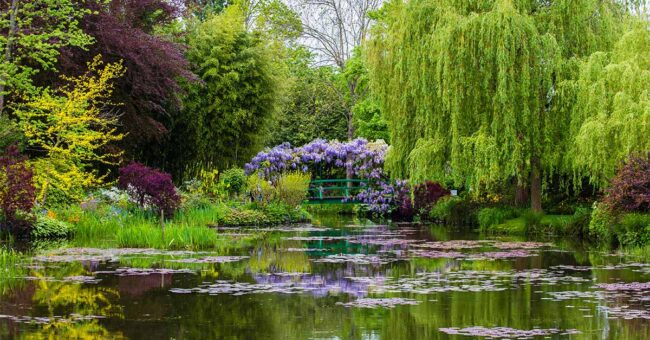
Born in Paris in 1840, Claude Monet’s artistic journey began with caricature creations in his youth, soon drawn to the natural beauty of the outdoors, initiating his painting career. His early works were influenced by traditional academic painting, but he quickly developed a unique style that became central to Impressionism.
In 1883, Monet moved to the small village of Giverny in Normandy, France. There, he rented a house with a garden, which over time became the focus of his passion and energy. He was not only an artist but also a passionate gardener. The Garden of Giverny gradually became the center of his creative work, not just his living space but an integral part of his artistic practice.
In Giverny, he continually planted, arranged, and reshaped the garden, striving to create the perfect natural landscape. He carefully selected plants, considering color, shape, and blooming seasons, ensuring the garden was a riot of color throughout the year. A special place in the garden was the famous pond, later inspiring his renowned “Water Lilies” series. This pond was not just a waterscape; it reflected Monet’s deep understanding of light and color variations.
His life in Giverny was not just a pursuit of natural beauty but a practice of his personal artistic philosophy. In this quiet village, away from the hustle of the city and the commercial art world, Monet found his refuge. Giverny became his experimental ground for exploring the relationships between light and color, nature and canvas. Here, he could experiment freely without concern for external judgment or constraints.
Creation and Maintenance of Giverny’s Garden
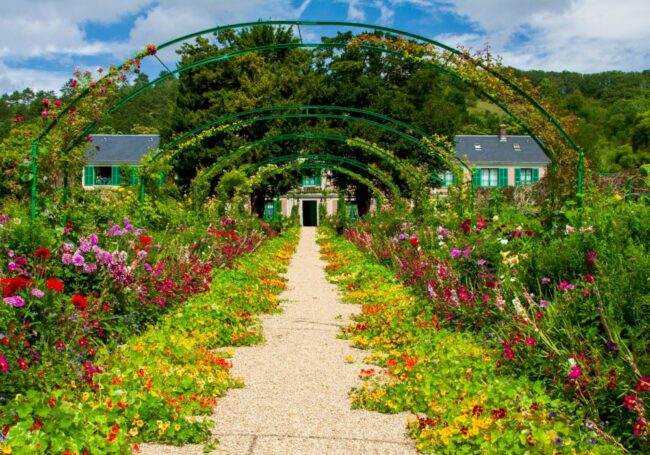
Giverny’s Garden was more than Monet’s home; it was a symbol of his creativity. Every inch of soil and every leaf in this garden revealed Monet’s limitless love and profound understanding of natural beauty. He treated Giverny as his artwork, personally designing every corner, meticulously selecting and arranging each plant. His garden was divided into two parts: a traditional garden, characterized by straight paths and symmetrical flowerbed arrangements, and a Japanese-style pond garden, centered around the famous green bridge and water lilies.
The garden was dynamic, changing with the seasons, each bringing different colors and atmospheres. Spring brought tulips, irises, and cherry blossoms; summer was dominated by roses and mallows; autumn continued the beauty with chrysanthemums and late-blooming roses; even in winter, carefully selected plants showcased the garden’s charm. These plants provided endless painting materials for Monet and reflected his deep understanding of nature and seasonal changes.
Monet’s maintenance of the garden was equally passionate. He employed several gardeners, personally directing their work to ensure every detail of the garden matched his artistic vision. Monet’s creative work in the garden was not just gardening; it was an extension of his artistic practice, a laboratory for exploring colors, light, and natural forms.
Representation of Giverny’s Garden in Monet’s Artworks
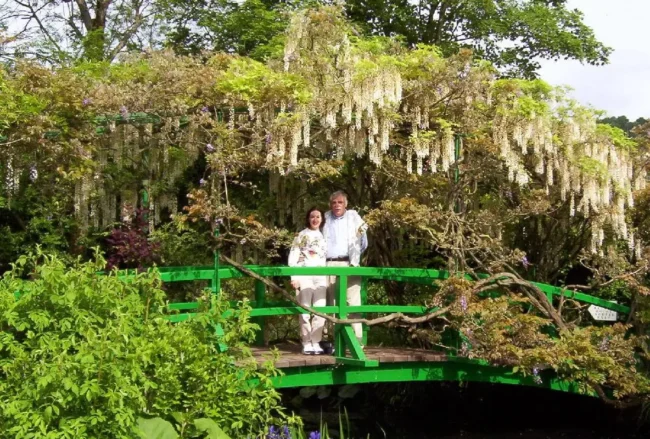
Giverny’s Garden held a central place in Monet’s artworks. Not only did he find inspiration in the garden, but he also set up his outdoor studio there. Whether on large canvases or small sketches, Monet sought to capture the light and color of the garden. Through these works, we see Monet’s deep affection and passion for Giverny.
Monet’s most famous Giverny series, “Water Lilies,” showcases the tranquil beauty of the pond and his sensitive capture of light and color reflections. In these works, the water surface reflecting the sky, clouds, and surrounding plants demonstrates how Monet used color and brushstrokes to convey the transparency and fluidity of water. These oil paintings are not just representations of natural landscapes but unique expressions of light and color.
Besides the “Water Lilies” series, he created many other works depicting Giverny’s paths, rose arches, and Japanese bridges. These works showed the garden at different times of the day, from the soft morning light to the golden glow of evening, capturing each moment’s unique beauty.
Monet’s works not only showed his deep understanding of natural beauty but also his continuous exploration and innovation in painting techniques. Through these works, he demonstrated how he transformed natural landscapes into vibrant and emotional art forms. Giverny’s Garden became a significant stage in Monet’s artistic exploration and a hallmark of his artistic achievements.
The Garden as a Fusion of Art and Nature
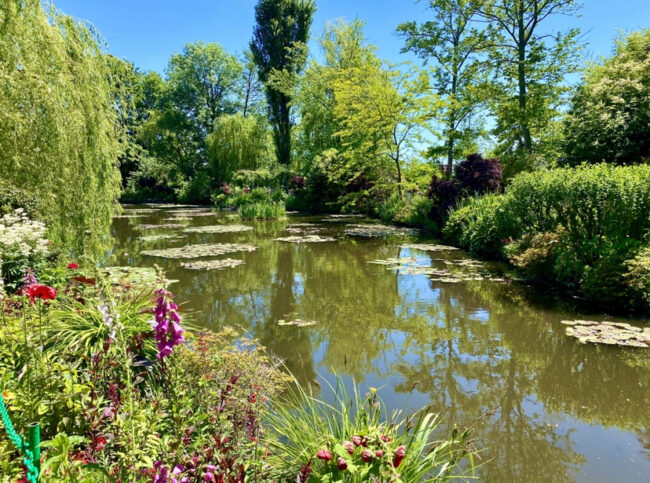
Giverny’s Garden was more than a source of natural beauty for Monet; it was a ground for exploring the fusion of art and nature. In this land, he was both a gardener and an artist, adjusting the garden’s layout to create stunning visual effects. Monet’s approach of treating the garden as a canvas not only changed the perception of gardening but also provided endless inspiration for his paintings.
Monet transformed Giverny into a true visual artwork. Through his choice and arrangement of plants, he created dynamic color scenes that changed with the seasons. In his eyes, every color and ray of light in the garden was a stroke on his canvas. This approach of seeing the garden as a canvas enriched his artistic creations and allowed him to explore colors, lights, and natural forms.
Moreover, Monet’s practices in Giverny reflected his respect and humility towards nature. He did not attempt to conquer or change nature but learned to coexist harmoniously with it. By observing the natural changes in the garden, his understood the complex relationships between light and shadow, color and form. These experiences not only enriched his artistic creations but also made him a more profound observer.
Analysis of Monet’s Later Works
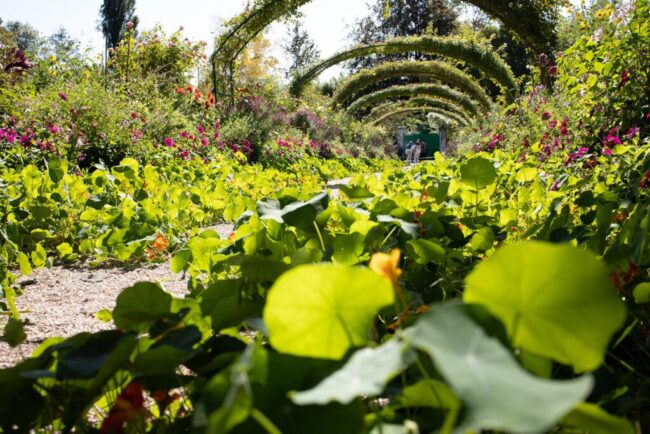
Monet’s later works, especially those created in Giverny’s Garden, marked a significant shift in his artistic style. These works focused more on abstract expressions of color and form, showing Monet’s deep exploration of light and shadow and natural landscapes.
The “Water Lilies” series is the most famous representation of his later period. Known for their bold compositions and disregard for details, these works no longer pursued traditional representation but focused on capturing the light and color reflections on the water surface. The colors in these paintings seem to flow and change, reflecting Monet’s profound understanding of nature’s constant transformation.
Besides the “Water Lilies” series, he created many other works depicting Giverny’s Garden during this period. These works showed a new perspective on natural landscapes, with bold colors and rough brushstrokes, conveying strong emotions and dynamic beauty. These pieces not only demonstrated Monet’s deep insights into the natural world but also his bold experimentation in art.
Monet’s later works showcased his maturity and confidence as an artist. He was no longer confined by traditional painting rules and techniques but expressed his artistic ideas more freely. Through these works, Monet showed his unique understanding of natural beauty and deep comprehension of the art of painting.
Legacy and Impact of Giverny’s Garden
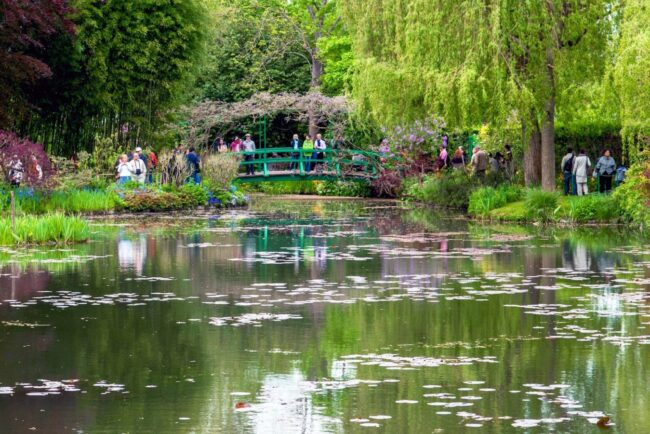
Following Claude Monet’s death in 1926, the fate of Giverny’s Garden entered a new phase. Though it fell into neglect for a time, it was eventually restored and opened to the public, becoming a sacred place for art and gardening enthusiasts. Today, Giverny’s Garden not only preserves Monet’s artistic legacy but continues to attract visitors and artists from around the world.
The restoration work of the garden strove to maintain Monet’s original designs, from the types and layouts of the plants to the famous Japanese bridge and water lilies pond. These elements not only recreated Monet’s artistic vision but became an important field for studying Monet and Impressionist art. Giverny’s Garden became a living museum, conveying Monet’s artistic spirit and pursuit of beauty through the land and the art it inspired.
Furthermore, Giverny’s Garden has had a profound impact on subsequent artists. Many modern painters, photographers, and designers have drawn inspiration from this garden, integrating Monet’s understanding of light, color, and nature into their own works. The garden is not just a physical testament to his art but a source of creativity, encouraging artists to view the relationship between nature and art from new perspectives.
Conclusion
By delving into Giverny’s Garden and its role in Monet’s life and work, we gain a more comprehensive understanding of the great painter’s artistic achievements and his philosophy of art. Giverny’s Garden was more than just his sanctuary and source of inspiration; it was a manifestation of his harmonious coexistence with nature. In this garden, Monet showed how he transformed the beauty of nature into unique artistic expressions.
Monet’s artistic career and his creation of Giverny’s Garden together tell a story of creativity, natural beauty, and artistic expression. The garden not only preserves his artistic legacy but also serves as a bridge between the past and present, artists and nature. Monet’s story and his Garden of Giverny will continue to inspire and enlighten future generations of artists and nature enthusiasts, perpetuating the artistic spirit and relentless pursuit of beauty of this Impressionist master.
